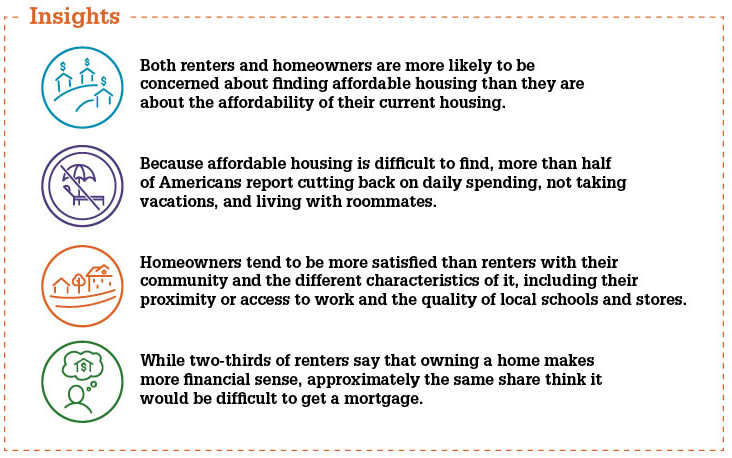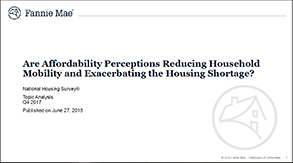Are Affordability Perceptions Reducing Household Mobility and Exacerbating the Housing Shortage?
 Across the country, housing affordability continues to be a challenge as the supply of homes for sale or rent has not kept pace with demand. The slow increase in single-family construction has been the subject of much discussion, with the four 'L's: (labor, lumber, lots, and laws) often serving as the focus. However, less attention has been paid to the supply of existing homes for sale, the trade-offs households weigh when choosing housing, and how households balance housing expenditures with other needs and wants.
Across the country, housing affordability continues to be a challenge as the supply of homes for sale or rent has not kept pace with demand. The slow increase in single-family construction has been the subject of much discussion, with the four 'L's: (labor, lumber, lots, and laws) often serving as the focus. However, less attention has been paid to the supply of existing homes for sale, the trade-offs households weigh when choosing housing, and how households balance housing expenditures with other needs and wants.
In order to gain insight on these issues, we used the Fannie Mae National Housing Survey® to ask renters and owners: 1) whether their current home is affordable; 2) to assess their own perception of affordability trends where they live; and 3) what sort of trade-offs were made in purchasing or renting their home.

We found that both renters and owners are much more likely to be concerned about the prospect of finding affordable housing than they are about the affordability of their current housing. Of particular relevance to the home sales market is that 8 percent of owners with a mortgage reported that their mortgage is not affordable, while 45 percent of owners overall think that affordable housing is difficult to find in their area. This gap, combined with the view of 44 percent of homeowners that housing has become less affordable over the past few years, may explain why homeowners are moving less frequently – and thereby contributing to the shortage of existing homes on the market.
Renters are also far more positive on the affordability of their current home than other homes in their area. One notable distinction is that higher income renters (in absolute terms and relative to area incomes) are more likely to report that their rent is not affordable. This perception may explain the growth in homeownership over the past two years and the importance of first-time homebuyers in the purchase mortgage market.
Due to the difficulty of finding affordable housing, more than half of survey respondents, especially renters, say they have taken actions to curtail non-housing expenditures, such as cutting back on daily spending, not taking vacations, and living with roommates. Most people tend to report being satisfied with the characteristics of where they live, including their proximity or access to work and the quality of local schools and stores. However, renters are less likely to be satisfied with these characteristics than owners, with the exception of access to public transportation.
While about two-thirds of renters say that owning makes more financial sense, approximately the same share of renters think it would be difficult for them to get a mortgage, primarily citing concerns about insufficient credit and affording a down payment. For some, these factors might take years to address.
Mark Palim
Vice President and Deputy Chief Economist
Economic and Strategic Research
June 27, 2018
Opinions, analyses, estimates, forecasts and other views of Fannie Mae's Economic & Strategic Research (ESR) Group or of survey respondents reflected in this commentary should not be construed as indicating Fannie Mae's business prospects or expected results, are based on a number of assumptions, and are subject to change without notice. How this information affects Fannie Mae will depend on many factors. Although the ESR group bases its opinions, analyses, estimates, forecasts and other views on information it considers reliable, it does not guarantee that the information provided in this commentary is accurate, current or suitable for any particular purpose. Changes in the assumptions or the information underlying these views could produce materially different results. The analyses, opinions, estimates, forecasts and other views published by the ESR group represent the views of that group as of the date indicated and do not necessarily represent the views of Fannie Mae or its management.

